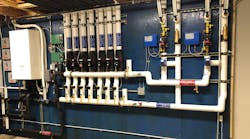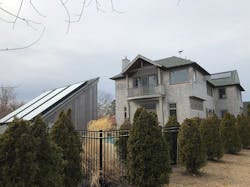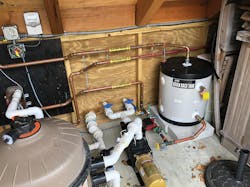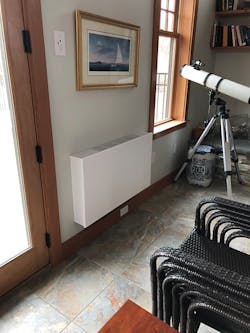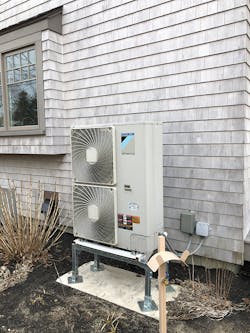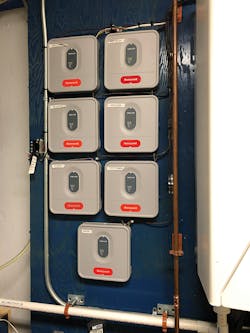Latest from Plumbing Contractor
Sponsored
MARTHA’S VINEYARD, MASS.—When homeowners choose to be more environmentally conscious with their decisions and take a more sustainable route for their home, they are generally lauded for their efforts. But when the homeowners of a 3,000-sq.-ft. house on the small, tourist island went all in on the “green train,” a mess of disparate mechanical components and empty promises of sustainable goals led to a wing and a prayer, and “let’s install everything green in one house and hope that it works.”
The original “green” intent was to maximize solar heat input into the home’s outdoor pool, domestic hot water, and space heating in an effort to reduce operating costs as much as possible. Although the home featured a very tight envelope with very good insulation, glazing and airtightness—heat loss was low at approx. 30,000 Btu/hr—energy analysis by South Mountain Company, a fully integrated architecture, engineering, building and renewable energy firm on the island, identified the chaos of the existing four-year-old mechanical system. They recommended Nelson Mechanical Design as the mechanical contractor with the engineering and design depth to envision and implement a rescue plan to reuse, rework and repurpose the good parts of the system and replace the parts that were unsalvageable.
According to Brian Nelson, co-owner and master plumber, Nelson Mechanical Design, besides the fundamental flaws in the installation itself—piping connected backward, buffer tank too small, inadequate flow through fan coils and radiant floors, which included floor heat in four bathrooms, kitchen and living room—it was a challenge to reuse and repurpose as much of the existing installation as possible and create a new design incorporating as much of the old installation as possible that would also be reliable and efficient.
“We were called in to untangle an unholy mess of drainback solar hot water, glycol solar hot water, an air-to-water heat pump providing chilled and hot water to fan coils—producing domestic hot water, fan coils with no condensate pans used for cooling, solar hot water storage, solar pool heat and a complicated electromechanical relay-based control system,” said Nelson.
Overly optimistic assumptions about solar hot water output led to complications with sending solar hot water for the pool or a large hot water storage tank to preheat domestic hot water. Additional flaws in the original design was wildly overestimating daily solar input from the glycol and drainback collectors on the roof. Expectations were expected that the solar input would be greater in the winter than it actually was which led to comfort and control issues in the heating mode.
To unravel the “unholy mess” of competing systems, the month-long facelift odyssey began with a rescue plan of initially removing a 700-gallon solar hot water storage tank. “We believe the original intent was to be able to store solar energy for later use. Unfortunately, it was not set up to stratify and hold the hottest water at the top; therefore, the solar hot water in the storage tank was never able to stay hot and often the water temperature in the tank was too low for space heat or domestic hot water. We separated the various solar systems so we could optimize each one; the solar glycol evacuated tube system was dedicated to preheating domestic hot water and the solar drainback system was dedicated to pool heating.”
Nelson and his crew of four replaced all seven fan convector wall units—that were not designed for cooling—with much better heating/cooling wall-mounted fan coil units from Jaga, which featured condensate pans and were designed for chilled water cooling.
Meanwhile, the Daikin Altherma air-to-water heat pump was always playing catch-up because the system waited until solar was not hot enough. This led to large lags in switching between producing chilled or hot water for fan coils and ramping up for domestic hot water production.
Because system water volume was too low, the cooling system was compromised by big slugs of hot water that went into the cooling system after every Altherma domestic hot water call.
Nelson repiped the Daikin Altherma unit, installed a bigger buffer tank, and ditched the domestic hot water production from the Daikin unit. “We removed the domestic hot water function from the Altherma, installed a larger Lochinvar stainless buffer tank, and connected the Altherma unit to the fan coil and radiant space heat loads. There would be no more solar hot water used for space heating. This stabilized the water temperature delivered for heating and cooling and made the home much more comfortable,” said Nelson.
For domestic hot water issues, Nelson used Apricus solar glycol evacuated tube collectors to preheat domestic hot water in the existing Daikin hot water tank. They added a Bradford White 80-gallon heat pump water heater as the final domestic hot water tank. This was a much more reliable way to have consistent domestic hot water and it still used solar—from the PV panels on the garage roof. After the Bradford White heat pump water heater, hot water was sent to a mixing valve. In the peak summer heat, the evacuated tube collectors would get the solar water temp up to 150 F.
Nelson’s team disconnected the solar drainback collectors, located on the pool house roof, from the main house and devoted them solely to pool heat. This greatly simplified control and increased solar input into the pool. When the pool needed heat, the drainback circulator started up, water was sent to the three 4- x 10-foot collectors, and the hot solar water was pumped through a pool heat exchanger. When the pool was hot enough, the circulator stopped and the water drained back into the drainback tank.
The existing radiant system had fixed temperature mixing valves for the various radiant floor zones. “This was nuts as the solar hot water temp was so variable; the end result was floors that were too cool or too hot,” said Nelson. “We removed the solar hot water connection and installed two Tekmar motorized mixing valve controls for the radiant zones. This let us have the Daikin Altherma air-to-water heat pump set its output temperature via outside reset and then the Tekmar motorized mixing controls would adjust that varying input to hit their mixing target,” said Nelson.
This permitted the fan coils to get the warmest water, the living room to get water that was warm enough for space heating, and the bathrooms and kitchen water warm enough for floor warming.
Finally, to give the homeowner remote control of the house, Nelson installed a Honeywell Lyric Wifi Internet thermostat, which acts as a “global” t-stat that controls the Daikin Altherma unit and the circulators going to the fan coils, and the radiant system. All thermostats—seven fan coils and five radiant—are set to 70 F and auto. The Lyric thermostat would override the 12 t-stats and would enable heating or cooling at the Daikin Altherma unit, and turn on the circulators. This meant that when the homeowner was away, they would only need to change one thermostat on their smartphone app to set back the entire house.
The homeowners have been very happy with the changes to the system. For the first time in four years, they had consistent domestic hot water, cooling from the fan coils, and a consistently warm pool. This past winter, the heating worked as expected with the various water temperatures.
“They were finally getting out of their house what they had been promised four years ago,” said Nelson. “Our rescue plan was able to integrate all of the different systems in an effective and energy-saving way.”


